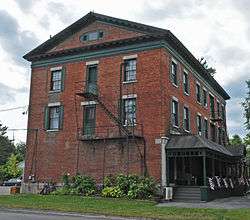Rogues' Harbor Inn
Rogues' Harbor Inn, also known as the Elm Grove Inn and Central Exchange Hotel, is a historic inn and tavern located at Lansing in Tompkins County, New York. It was built between 1830 and 1842 by Major General Daniel D. Minier, and is a three-story brick building in the Greek Revival style. It is a 40-foot-deep by 80-foot-wide rectangular building on a stucco-coated fieldstone foundation with a gable roof. It features a full-width porch with a roof supported by turned posts. The author Grace Miller White (1868–1957) used it as the inspiration for the setting for her novel Judy of Rogues Harbor.[2] It has continued to operate as a bed and breakfast country inn and restaurant. As of January 2019, their website[3] reports "Restaurant reopening Spring 2019."
Rogues' Harbor Inn | |
 | |
  | |
| Location | 2079 E. Shore Dr., Lansing, New York |
|---|---|
| Coordinates | 42°32′15.97″N 76°30′19.67″W |
| Area | 0.6 acres (0.24 ha) |
| Built | 1842 |
| Architect | Kelsey, Lemuel, Nelson Morgan |
| Architectural style | Greek Revival |
| NRHP reference No. | 09000657[1] |
| Added to NRHP | August 26, 2009 |
History
The Central Exchange Hotel was the first brick structure built in Lansing. Construction began in 1830, when Major General Daniel D. Minier secured the services of Lemuel Kelsey of Dryden, and apprentice carpenter, Nelson Morgan of Lansing, to erect this three-story building. The main object of the building was to become a rooming house, a store and living quarters.
At a cost of $40,000, Major General Daniel D. Minier situated the building on family land purchased from Nicholas Van Rensselaer[4] (Military Lot #87 of the Central New York Military Tract).[5] The Central Exchange Hotel received its name because it was on the road between Ithaca, and Auburn and stage coaches would stop there to exchange horses.
Seven years after completion, Major General Daniel D. Minier died and his remains were placed in the Asbury Cemetery.
The Inn
The three-story building was largely colonial, having wooden pillars across the front and metal balconies built across each story on the north and west sides. The first floor contained living rooms, a grill and bar with a huge hall extending the length of the structure through the center. The second floor contained sleeping rooms and the third, the famous ballroom. Connecting all the floors was a spiral stairway, which was considered a unique piece of workmanship for the time.[6]
Above this was the attic, which was originally lighted by two oval leaded glass windows at either end. Here, were two huge zinc-lined cisterns expertly caulked and built of whitewood planks. One was for drinking water pumped by a windmill and piped throughout the building, and the other was to catch the soft water from the roof used for the kitchen.
It was listed on the National Register of Historic Places in 2009.[1]
References
- "National Register of Historic Places". WEEKLY LIST OF ACTIONS TAKEN ON PROPERTIES: 8/24/09 THROUGH 8/28/09. National Park Service. 2010-09-04.
- unknown. "National Register of Historic Places Registration: Rogues' Harbor Inn". New York State Office of Parks, Recreation and Historic Preservation. Retrieved 2011-05-15. See also: "Accompanying 18 photos".
- http://www.roguesharbor.com/
- Bielinski, Stefan. "Nicholas Van Rensselaer". New York State Museum. Retrieved 10 March 2012.
- Bement, Louise (1984). Town of Lansing Its Beginning. Lansing, NY: Louise Bement. LCCN 87119284.
- Youngs, Estella (1962). "Hotel Noted Landmark". Ithaca Journal.

